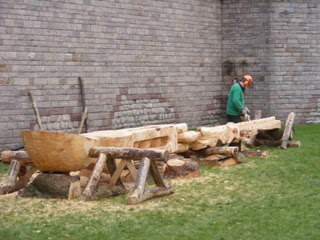What do you mean, you don’t know what a love spoon is?
A love spoon is a gift given between lovers that originates in the middle ages in Wales. Patty and I found about this during our research for a travel article in Wales (see previous post). Designs representing love, such as intertwined braids, are carved into the handle. The couple is supposed to hang it from a nail to bring them future happiness. They come in many different designs:
And many different sizes. While we were in Cardiff at Christmas 2007, a chap was just finishing the largest carved love spoon in the world. He was doing it with a chainsaw on the grass in front of Cardiff Castle:
I think he was responsible for carving the previous ‘largest love spoon in the world.’ I recalled this because of the Richard Burton anecdote that came back to me last weekend. But also because it shows how the loony obsessiveness of art-making is not confined to addicts of gigantism such as Richard Serra or Anselm Kiefer.

